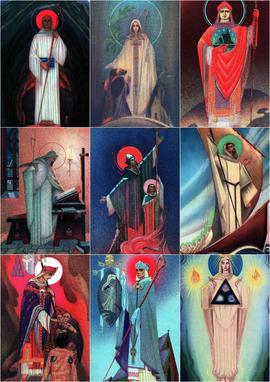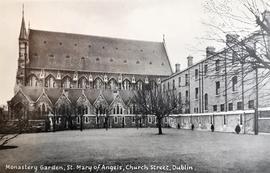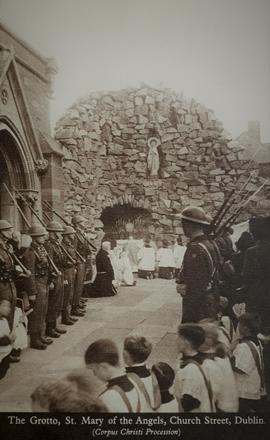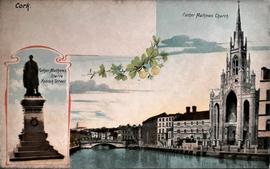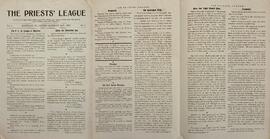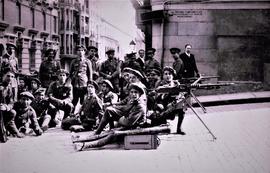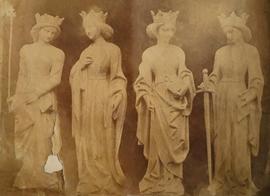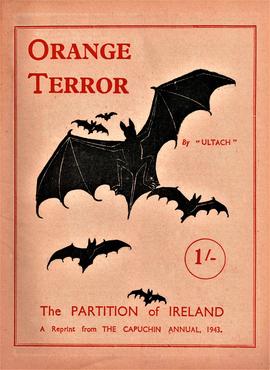Sets of postcard prints of Irish Saints designed by Richard King (1907-1974) and commissioned for 'The Capuchin Annual'. The prints depict St. Brendan, St. Patrick, St. Ita, St. Fiacre, St. Senan, St. Colmcille, St. Brigid and St. Laurence O’Toole. Each one of the postcards shows the Saint (in colour) on one side, with a postcard layout on the reverse with the name of the Saint, the artist (Risteárd Ó Cionga) and the copyright statement.
A set of four photographic postcard prints of the exterior (and friary garden) and interior (High Altar and Sanctuary) of St. Mary of the Angels, Church Street. The annotated titles are printed: ‘Sanctuary, St. Mary of the Angels, Church Street, Dublin’.
A set of three pictorial postcard prints of the Grotto at St. Mary of the Angels, the Calvary outside the church, and a Corpus Christi procession and ceremony at the Grotto. One of the cards has a manuscript annotation: ‘Grotto dismantled and transferred to Priorswood (County Dublin) in the 1990s’.
A set of three photographic postcard prints of the exterior of Holy Trinity Church, viewed from opposite bank of the South Channel of the River Lee in Cork. One of the prints is colourized and has an insert of the Father Mathew Statue on St. Patrick's Street in Cork.
Postcard prints of the interior and exterior of the Capuchin Friary, Kilkenny. The exterior is taken at the junction of Friary Street with Pennyfeather Lane. Published by 'Kilkenny People' Printing Ltd. There are numerous copies of each print.
A copy of a flier titled the ‘Priests’ League’ (Vol. 1, No. 1, 1908). The flier was printed issued in Scottdale, Pennsylvania, and was most likely issued by a local branch of the Catholic Total Abstinence Union of America.
The file includes press-agency (Keystone View Company, Fleet Street, London) photographs of the proclamation of the Spanish Republic in 1931. The prints are annotated on the reverse and include:
• Scenes in San Sebastian at the proclamation of the Republic. 17 Apr. 1931.
• ‘A street at San Sebastian, Spain, crowded with enthusiastic Republicans, after the Republic had been proclaimed there’.
• Soldiers armed with machine guns photographed outside a Church in Madrid, waiting for rioters. 13 May 1931.
• ‘A charge is to be brought against King Alfonso on the grounds that he assisted in the promotion of disturbances in Spain with the object of overthrowing or discrediting the Republican government. As a result of the serious fighting between the Republicans and Monarchists grave results have been registered. The Jesuit convent of Iglesais, and other religious institutes have been attacked and burned down by Republican communists’.
• Sailors joining in the joyous celebrations after the proclamation of the Catalonian Republic in Barcelona. 17 Apr. 1931.
• Anti-Monarchist rioting in Madrid. 12 May 1931.
• ‘Civil Guards dispersing the huge crowd of rioters in the streets of Madrid. Popular hostility to the manner in which the monarchist propaganda is being organised in Madrid culminated in serious anti-monarchist riots, when the Civil Guard fired on the great crowds, during which many casualties were reported. As a result of the tense situation, martial law has been proclaimed in the city’.
• The arrival of Niceto Alcalá-Zamora y Torres, President of the Republic, in Barcelona. c.Dec. 1931.
• Scenes in Madrid after proclamation of Republic. 16 Apr. 1931.
• ‘A woman hoisting the Republican flag surrounded by huge crowds after the proclamation of the Republic in Madrid’.
• The King of Spain’s bodyguard entering the Royal Palace in Madrid. 14 Apr. 1931.
• ‘It is officially stated that King Alfonso of Spain has abdicated his throne and it is reported that he is leaving tonight for Portugal with his family, en-route to England’.
• ‘The Place de Gracia in Barcelona, thronged with demonstrators during the election campaign last Saturday’. 29 June 1931.
• Spanish exile returns to Madrid. 17 Apr. 1931.
• ‘Major Franco, the airman revolt leader seen under the Republican flags held by followers when he left the train at a wayside station, during his journey from France to Madrid, to where he is returning from exile under the new regime’.
• Republican flag being hoisted on the top of a motor car after the proclamation of the Republic in Madrid. 16 Apr. 1931.
• The statute of the late Primo de Rivera, the former Dictator of Spain, being hauled through the streets with a rope round the neck, by Republican demonstrators. The statue was destroyed, and the site replaced by the statue of a Republican leader. 18 Apr. 1931.
• A Republican leader carrying the Republican flag being carried shoulder high by enthusiasts to the Town Hall after the proclamation of the Catalonian Republic in Barcelona. 17 Apr. 1931.
• Socialist demonstration in memory of Pablo Iglesias in Madrid. 21 Apr. 1931.
• A group of young republicans wearing Phrygian bonnets and carrying Republican flags in Barcelona. 29 June 1931.
• Crowds welcome the arrival of Republican leaders at Madrid’s train station. 17 Apr. 1931.
• Members of the new Spanish Republican government. 17 Apr. 1931.
• The release of prisoners at San Sebastian following the proclamation of the Spanish Republic. 17 Apr. 1931.
• Armoured cars guard banks against rioting in Madrid. 15 May 1931.
• King Alfonso XIII of Spain receives the new Italian Ambassador just before the proclamation of the Second Spanish Republic and his flight into exile.
Photographic prints annotated on the reverse: ‘J. Pearse / Queen’s Robing Room / House of Lords’. The images appear to show some of the statues of the twenty-six princesses extant in the Queen’s robing room in the House of Lords, London. Pearse made carvings of princesses and robes and crowns for the ‘throne room’ (or the ‘Queen’s robing room’) in the House of Lords in the Palace of Westminster.
Receipt and expenditure book of the Capuchin Publications Office. The accounts provide details of cash lodgements, and income accruing from advertising, sales of the 'Orange Terror' offprint, the 'Angelic Shepherd', the ‘Irish Saints’ Cards’, designed by Richard King, and from the Association Patrons of 'The Capuchin Annual'. Includes figures for expenditure in respect of salaries, postage, and payments made to John English & Co., printers. The first part of the journal includes a list of promoters (possibly for 'The Capuchin Annual') and two inserts of accounts from 1938 which are seemingly unconnected to the Publications Office.
Ledger and account book for the Capuchin community at St. Mary of the Angels, Church Street. The ledger provides a daily record of income received and expenses incurred by the community. Notes are made of income derived from mass stipends, street collections, sodalities, Third Order payments and temperance publications. Reference is also made to monies received from donations, alms, bequests, and cheques. Expenses include travel tickets, lay staff wages, groceries, building repairs and other sundries. An entry from November 1908 refers to the payment of £30 to John Keogh for the completion of work on the Calvary at St. Mary of the Angels. The entries are periodically signed by the Friary Guardian and by the Provincial Minister at visitations.
Manuscript annotation on first page reads:
‘Particulars supplied to the Archbishop at his Grace’s request.
Church of St Mary of the Angels – building was begun June 12th 1868. Total cost including altar pulpit, altar rails, organ but not furniture was £60,000
Architect, James McCarthy
Contractors, Michael Meade & son.
The Sacred Heart Chapel built as an aisle church was begun in March 1908. Cost: £4,000.
Architects, Ashlin & Coleman
Contractors, Thomas Connolly’.
A later annotation (in the hand of Fr. Angelus Healy OFM Cap.) reads:
‘House ledger from October 1907 (Fr. Laurence Dowling, Guardian) to December 1929 (Fr. Angelus Healy, Guardian)’.
A List of Friary Guardians is supplied:
1907-1910, Fr. Laurence [Dowling]
1910-1913, Fr. Angelus [Healy]
1913-1916, Fr. Augustine [Hayden]
1916-1919, Fr. Fiacre [Brophy]
1919-1925, Fr. Benedict [Phelan]
1925-1928, Fr. Edward [Walsh]
1928-1931, Fr. Angelus [Healy]
1931-1934, Fr. Edward [Walsh]

